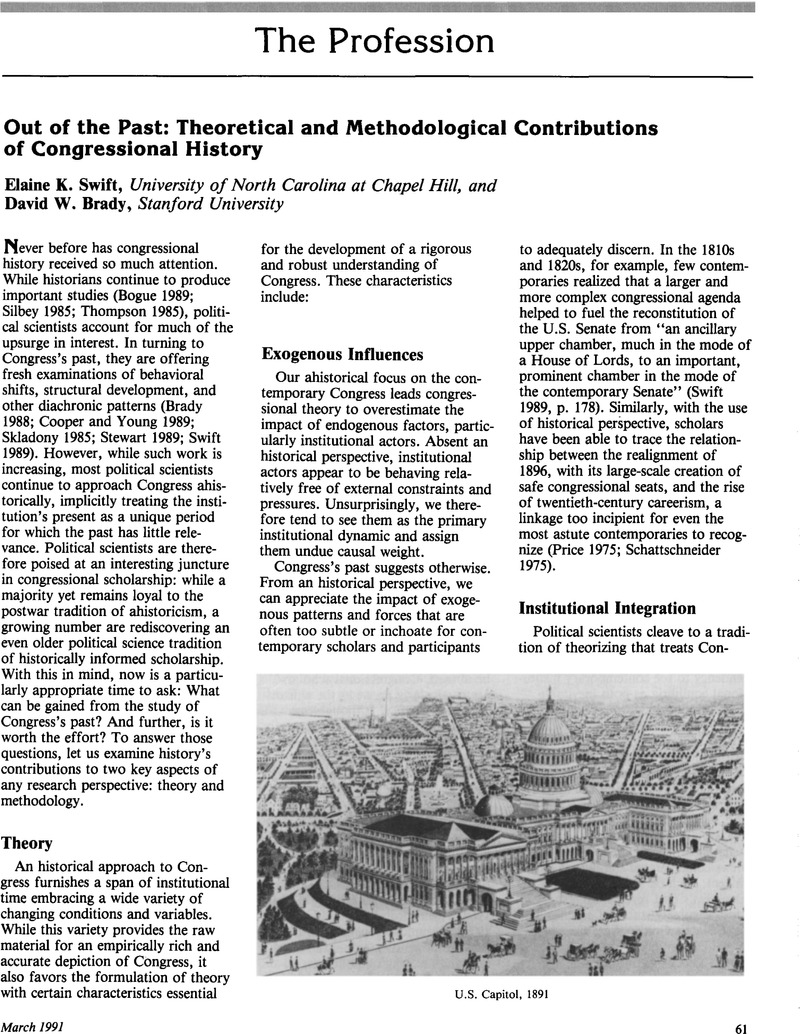No CrossRef data available.
Article contents
Out of the Past: Theoretical and Methodological Contributions of Congressional History
Published online by Cambridge University Press: 02 September 2013
Abstract
An abstract is not available for this content so a preview has been provided. As you have access to this content, a full PDF is available via the ‘Save PDF’ action button.

- Type
- News
- Information
- Copyright
- Copyright © The American Political Science Association 1991
References
Alford, John R, and Brady, David W
1989. “Personal and Partisan Advantage in U.S. Congressional Elections, 1846–1986.” In Dodd, Lawrence C. and Oppenheimer, Bruce I, eds., Congress Reconsidered. 4th ed.
Washington, DC: Congressional Quarterly Press.Google Scholar
Bogue, Allan G.
1989. The Congressman's Civil War. Cambridge: Cambridge University Press.CrossRefGoogle Scholar
Brady, David W.
1988. Critical Elections and Congressional Policy Making. Stanford: Stanford University Press.CrossRefGoogle Scholar
Cooper, Joseph and Brady, David W
1981. “Toward a Diachronie Analysis of Congress.” American Political Science Review
75: 988–1006.CrossRefGoogle Scholar
Cooper, Joseph, and Young, Cheryl D
1989. “Bill Introduction in the Nineteenth Century: A Study of Institutional Change.” Legislative Studies Quarterly
14: 67–106.CrossRefGoogle Scholar
Dodd, Lawrence C.
1987. “Woodrow Wilson's Congressional Government and the Modern Congress: The ‘Universal Principle’ of Change.” Congress & The Presidency
14: 33–50.CrossRefGoogle Scholar
Fiorina, Morris P., Rohde, David, and Wissel, Peter. 1975. “Historical Change in House Turnover.” In Ornstein, Norman J., ed., Congress in Change: Evolution and Reform. New York: Praeger.Google Scholar
Gilligan, Thomas W., and Krehbiel, Keith. 1989. “Asymmetric Information and Legislative Rules with a Heterogeneous Committee.” American Journal of Political Science
33: 459–490.CrossRefGoogle Scholar
Garand, James C, and Gross, Donald A
1984. “Changes in the Vote Margins for Congressional Candidates: A Specification of Historical Trends.” American Political Science Review
78: 17–30.CrossRefGoogle Scholar
Huckabee, David C.
1989. “Reelection Rates of House Incumbents: 1790–1988.” Washington, DC: Congressional Research Service, Library of Congress.Google Scholar
Krehbiel, Keith. 1990. “Are Congressional Committees Composed of Preference Outliers?” American Political Science Review
84: 149–164.CrossRefGoogle Scholar
Lienesch, Michael. 1988. New Order of the Ages: Time, the Constitution, and the Making of Modern American Political Thought. Princeton: Princeton University Press.Google Scholar
Loewenberg, Gerhard, Patterson, Samuel C, and Jewell, Malcolm E
1985. Handbook of Legislative Research. Cambridge, MA: Harvard University Press.Google Scholar
McCoy, Drew R.
1980. The Elusive Republic: Political Economy in Jeffersonian America. Chapel Hill: University of North Carolina Press, Institute of Early American History and Culture.Google Scholar
Peabody, Robert L.
1969. “Research on Congress: A Coming of Age.” In Huitt, Ralph K. and Peabody, Robert L., eds., Congress: Two Decades of Analysis. New York: Harper & Row.Google Scholar
Polsby, Nelson W.
1968. “The Institutionalization of the U.S. House of Representatives.” American Political Science Review
68: 144–168.CrossRefGoogle Scholar
Price, H. Douglas. 1975. “Congress and the Evolution of Legislative ‘Professionalism.’” In Ornstein, Norman J., ed., Congress in Change: Evolution and Reform. New York: Praeger.Google Scholar
Schattschneider, E. E.
1975. The Semisovereign People. Hinsdale, IL: The Drysdale Press.Google Scholar
Shepsle, Kenneth A.
1979. “Institutional Arrangements and Equilibrium in Multidimensional Voting Models.” American Journal of Political Science
23: 27–48.CrossRefGoogle Scholar
Shepsle, Kenneth A, and Weingast, Barry R
1987. “The Institutional Foundations of Committee Power.” American Political Science Review
81: 85–104.CrossRefGoogle Scholar
Sinclair, Barbara. 1989. The Transformation of the U.S. Senate. Baltimore: The Johns Hopkins University Press.CrossRefGoogle Scholar
Skladony, Thomas W.
1985. “The House Goes to Work: Select and Standing Committees in the U.S. House of Representatives.” Congress and the Presidency
12: 165–188.CrossRefGoogle Scholar
Stewart, Charles H.
1989. Budget Reform Politics: The Design of the Appropriations Process in the House of Representatives, 1865–1921. New York: Cambridge University Press.CrossRefGoogle Scholar
Swift, Elaine K.
1987–1988. “The Electoral Connection Meets the Past: Lessons from Congressional History, 1789–1899.” Political Science Quarterly
102: 625–645.CrossRefGoogle Scholar
Swift, Elaine K.
1989. “Reconstitutive Change in the U.S. Congress: The Early Senate, 1789–1841.” Legislative Studies Quarterly
14: 175–204.CrossRefGoogle Scholar
Thompson, Margaret Susan. 1985. The “Spider Web.” Congress and Lobbying in the Age of Grant. Ithaca: Cornell University Press.Google Scholar
Watts, Steven. 1987. The Republic Reborn: War and the Making of Liberal America, 1790–1820. Baltimore: Johns Hopkins University Press.CrossRefGoogle Scholar
Wood, Gordon S.
1969. The Creation of the American Republic, 1776–1787. New York: Norton.Google Scholar




